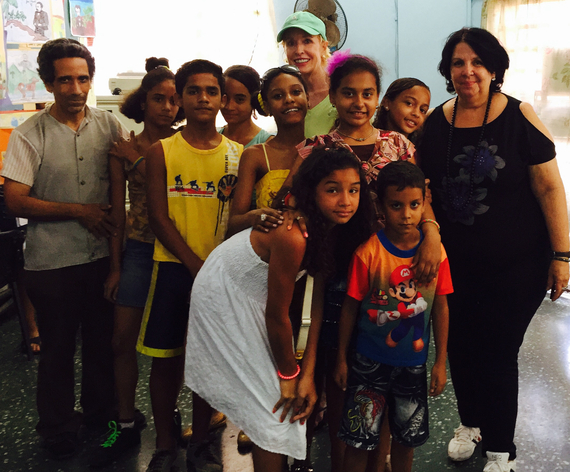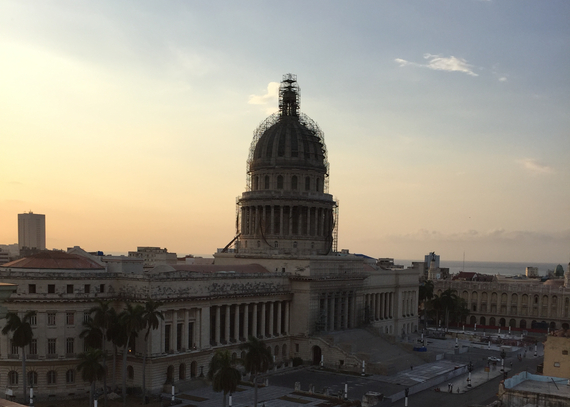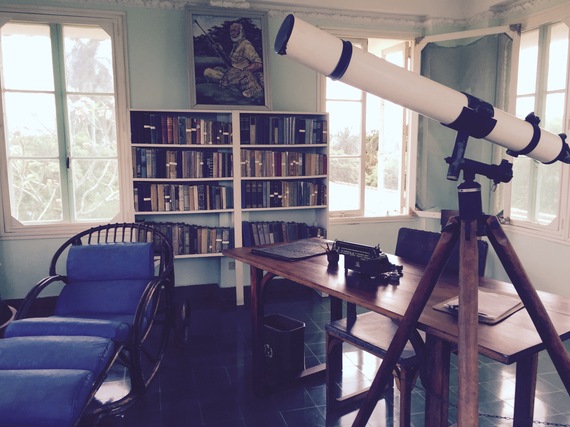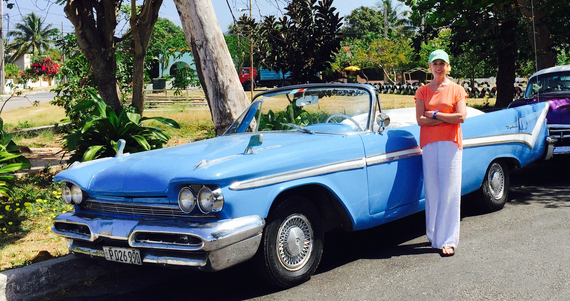Reflections on a Cuba Visit
Kathy Kemper | Founder and CEO, Institute for Education | Posted:
Havana is a fractured place–beautiful, colorful, and hopeful, but at the same time, poor, deprived and repressed.
Old Havana is full of charm, life, music, color, and tourists. It features architectural styles, including neoclassical and grand colonial, with courtyards and covered walkways, and some Art Deco. There are five fabulously impressive public squares. The Capitol building in Havana looks like the Capitol in Washington, DC, only smaller.
My favorite attractions were the Museo Hemingway, Museo de la Revolución, and the Cigar Factory. The restoration efforts seem endless, but no one seems to know the plan for when anything might be completed.
Central Havana, on the other hand, is poor and developing. It is common for many generations to live under a single room. Homes are generally dilapidated and, by Western standards, would be considered slums. Many buildings are falling apart from neglect. People don’t own homes; instead, they trade them as people die or babies are born.
Havana is generally very safe; there are few gun or knife fights. While there are some robberies, tourists are generally left alone. But the country teems with unrealized potential. Pre-revolution Cuba was flourishing with newspapers and magazines, but today there is very little in the way of independent media. José Marti and Ché Guevara are national heroes, but there were no pictures of Castro on plazas or street signs. There was, in fact, no signage or advertising at all. And of course, no Starbucks or McDonald’s.
Although Havana is a port, there were no sailboats, fishing boats, or any pleasure boats. In fact, there was hardly a beach community. On the boardwalk along the Atlantic called Malecón, people were all looking inwards, never out at sea. There were few joggers and no restaurants with views of the sea.
The restaurants, called ‘paladares’, are small family-run businesses that are permitted to operate privately by paying a monthly tax to the state. No locals frequent these establishments, only tourists, due to the expense. We found some very nice ones with lovely gardens, but some were uninteresting and expensive, located in small rooms filled with tourist groups.
The state has set up an extensive vocational school system where students study masonry, woodcutting, tile building, and fresco refurbishing. I wondered where they got the authentic craftsmen to do this, but no one knew.
Although the Cuban educational system is highly regarded, many of our tour guides did not have any information on subjects that the state does not want Cubans to know about. When I asked one of our guides to tell me more about Batista, the Cuban dictator who was overthrown during the revolution, she knew a couple of dates but had no stories or insights. As many Internet sites are blocked and most Cubans lack access to the Internet, it is almost impossible for locals to obtain basic information or context.
Cubans who work in tourism do have some connectivity in their offices, but it is spotty. The Internet connection was equally unreliable in hotels, even the best. It was impossible to download any newspapers. One paper in Cuba called Granma, named after the boat Fidel took from Mexico for the purpose of overthrowing Batista, was, in fact, more of a pamphlet.
I asked another tour guide if Castro would be embalmed like Stalin, Lenin, Mao, Kim Jong-il, and other Communist leaders, but she had no idea what I was talking about. No Cubans seem to know much about Fidel–his health, his family, or where he lives. With no press, how could they? They are hopeful with Raul. They all say, “it is about time,” meaning they welcome change.
We spoke to several economists at the University of Havana. Some had studied decades ago in the United States or Canada. While they often get invited to conferences in the States, they can never get a visa to attend. One Ph.D. economist said he got a call maybe a year after a conference asking if he was still interested in attending. Of course, the forum had happened 11 months earlier.
There’s fairly light traffic–just a few old Russian cars and tourist-type, two-person taxis called Cocomobiles. Our Cocomobile driver had a PhD in computer science, but he made a lot more money driving a tourist taxi. I asked him if he had ever been off the island. He eagerly said that he had been to Mexico and Grand Cayman and explained that after university, he and a few pals got a job on a Cuban boat. He then admitted, however, that they were not allowed off the boat when it docked, so he had really only seen these other places.
Most Cubans, even highly educated ones, earn little–the equivalent of $20 a month. They get ration cards for soap and chicken (a two-pound ration per person). I asked to look at the ration cards, which are kept in index boxes. There are no digital records, of course.
Rice, beans, and toothpaste are fairly standard items. But when something as precious as eggs or fruit shows up at the ration store, lines form in a moment, and people will wait for hours. Cubans often joke that their national past time is waiting in line. On the weekend, we saw an ice cream stand. The line stretched for seven or eight blocks, and it was hot, but people seemed to be happy, making friends, and taking it all in stride. If you see an iPhone 3 or 4, Nike’s, or designer jeans, these are all from American relatives. Cubans are very proud of their local art and music.
The monetary system, in any case, is in tatters. Everyone gets paid in Cuban pesos. But CUCs, or the Cuban convertible peso, is the currency for people working in the travel industry. There are absolutely no credit cards. The hotel, tour guides, drivers, bell boys, and restaurants for tourists all took tips from tourists in CUCs. So anyone who works in the tourism industry makes a lot more than even PhDs and doctors. Our cigar guide, for example, makes roughly 120 dollars in CUC-denominated tips, while his wife, a neurosurgeon, makes the equivalent of only 24 dollars a month in Cuban pesos.
I visited a community center in Central Havana called Casa del Niño y de la Niña, which works to keep kids off the streets after school. It consists of a single large room that is decorated with kids’ coloring. The theme when I visited was José Marti and children’s rights. The center has only one computer, which was an 80’s model. Internet costs eight dollars an hour ,if you can ever get it, which is far too expensive, of course. The children do learn how to use a keyboard, however, and play games and music on the computer.

Casa del Niño y de la Niña Community Center
I met about 15 children ranging from kindergarteners to seventh graders. Because it was spring break, they were not in uniforms. While there is no air conditioning, the place is very clean, with old plastic chairs that were donated by UNICEF. They were beautiful kids–happy and full of hope. They love the United States, and a few know who Obama is. They like French fries and pizza and know what ice cream is, though only a few have tasted it. All live with at least three generations.
They sang for me and invited me to dance. Each one recited a sentence on what they had been learning about, regarding the rights of children in Cuba.
“I have a right to not be hungry.”
“I have a right to be safe.”
“I have a right to have a home.”
“I have a right to go to school.”
“I have a right to study.”
“I have a right to have a right.”
Countries like North Korea and Burma are so far away and cut off that they can seem hard to grasp. But Cuba is close to our shores and with so many Cuban-Americans in the United States, it was disquieting to see the country in such a state of deprivation. The Cuban people have so much potential, and El Comandante has done such a disservice to them.
View online: Huffington Post | Washington Dipolmat



